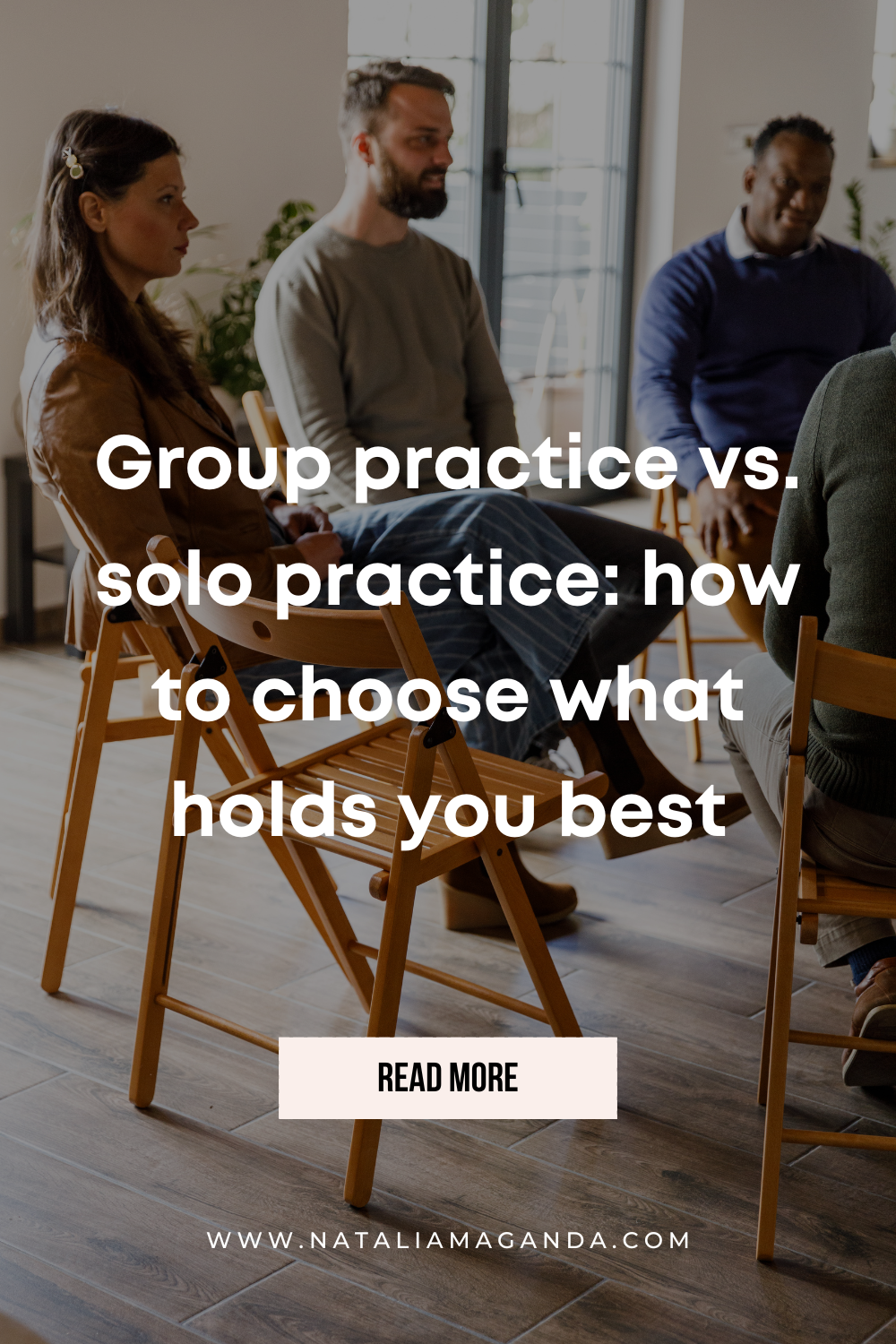Group practice vs. solo practice: how to choose what holds you best
Because your practice model shapes your life—not just your business. As a therapist, your work is deeply personal. It’s not just what you do—it’s who you are. So when it comes to choosing between running a solo practice or joining a group, the decision carries emotional weight. It’s not just a business choice—it’s a lifestyle decision that shapes your energy, freedom, community, and financial future.
This blog is here to help you navigate that decision with clarity, empathy, and insight. We’ll explore both models through the lens of emotional alignment, practical logistics, and long-term sustainability. Whether you’re dreaming of running your own private practice or imagining yourself in a collaborative community, this post will give you the insight you need.
In case you’re new here, I’m Natalia, a website designer for therapists, and I help private practice owners like you build brands and websites that reflect the heart of your work. Because how you show up—online or in person—matters.
Let’s explore the emotional, logistical, and clinical realities of group vs solo practice. And more importantly, let’s help you find what feels most aligned for you.
What is a group practice?
A group practice is a collective of licensed providers—therapists, psychologists, coaches, or healthcare professionals—who work together under one business structure. They typically share office space, administrative staff, branding, and sometimes even referrals or clinical responsibilities.
Group practices can be structured in many ways:
- Equal partners with shared decision-making
- One owner and multiple W-2 or 1099 clinicians
- A collaborative of independent therapists who share space and resources
Think of it as a shared home with many rooms. Each clinician has their own way of working, but the space is held together by shared systems, mutual values, and collective support.
It’s not just about sharing rent—it’s about building something together. A group practice can feel like a safety net, a creative collective, or even a professional family depending on how it’s structured.
What is considered a solo practice?
A solo practice is just that—you, running your own practice. You make the rules, call the shots, and build everything around your vision. It’s a deeply personal model of working that allows for full freedom and responsibility.
You might:
- Rent your own office (or work virtually)
- Handle your own admin or outsource it selectively
- Create a personal brand that reflects your voice, not a group identity
Solo doesn’t mean you’re alone—but it does mean you’re the architect of everything, from fees to schedules to decor. Every decision is yours, every outcome a reflection of your values and efforts.
What is the difference between solo and group practice?
The core differences come down to autonomy, collaboration, financial structure, and support. Here’s a comparison:
| Aspect | Solo Practice | Group Practice |
|---|---|---|
| Autonomy | Full control over all decisions | Shared governance or leadership structure |
| Support | Must source your own supervision or community | Built-in peer support and admin staff |
| Financial Risk | You assume all income/expenses | Costs and revenue often shared |
| Branding | Fully personalized | Aligned with group brand/voice |
| Growth | You grow at your own pace | Opportunities for mentorship, leadership, expansion |
This difference in structure changes the way you show up day to day. Solo practice offers sovereignty, but group practice offers solidarity. Some therapists even blend both over time.
Emotional and practical benefits of each model
Benefits of solo practice
- Creative Freedom: From your therapy approach to your website design, every choice is yours.
- Deeper Client Bonds: Clients get to know you, your brand, and your process intimately.
- Full Autonomy: Control your own schedule, policies, and income goals.
- Flexible Growth: Expand, slow down, or pivot—without negotiating with a team.
- Alignment with Values: Every aspect of your practice can be filtered through your personal vision.
Solo practice offers therapists the ability to deeply align their external work with their internal rhythm. It supports those who value independence, creative freedom, and deep personal vision.
Benefits of group practice
- Peer Collaboration: You're surrounded by others who understand the emotional weight of the work.
- Shared Costs: Pooling resources means you can afford better systems, tools, and support.
- Administrative Help: Many group practices have reception, billing, or marketing handled.
- Ongoing Learning: You’re regularly exposed to new methods, ideas, and case perspectives.
- Community Culture: You don’t have to carry the weight of the business alone.
Group practice supports therapists who value connection, collaboration, and stability. It provides a cushion of support that can be both professional and emotional.
What are the disadvantages of group practice?
Every practice model has its own rhythm. And sometimes, group practice—while supportive in many ways—can feel like dancing to someone else’s beat. Here’s what to consider:
Less flexibility with your time and systems
In many group practices, you’ll follow existing schedules, documentation protocols, and cancellation policies. This can be grounding for some—but stifling for others. If you value fluidity in your calendar or want to experiment with different structures, this limitation may feel like friction rather than flow.
Lower income potential
While group practice can offer a steady paycheck or a split-based model, it often means sharing revenue. For some, this tradeoff brings ease. For others, especially those working at full capacity, it can feel like leaving money on the table—without the autonomy to adjust.
Value mismatch
If the practice’s vision, tone, or clinical approach doesn’t match your own, it can create quiet tension. Maybe you're passionate about trauma-informed care, but the group prioritizes brief solution-focused therapy. That dissonance can wear on your spirit over time.
Emotional labor and unclear roles
When you’re part of a group, you’re not just responsible for your clients—you’re also holding space for colleagues, navigating internal dynamics, and sometimes absorbing the emotional ripple effects of leadership gaps or poor boundaries. Even in supportive teams, that labor is real.
The question isn’t just "What will I earn?"—it’s "What will this cost me emotionally?" Group practice can be beautiful, but it’s not one-size-fits-all. Be honest about what you need to feel grounded, seen, and free inside your work.
Let your decision center your peace. Always.
Why group work is important
Even if your heart pulls you toward solo practice, one truth remains—we’re not meant to do this work in isolation. Therapy is relational by nature, and that includes the therapist, too.
You spend your days holding space for others. Sitting with pain, joy, grief, and uncertainty. And while you may be gifted at creating safe spaces for your clients, it’s easy to forget that you also need spaces where you are held.
That’s where group work can be incredibly powerful.
Community: because therapists need people, too
Behind every strong therapist is a human being. A group setting gives you access to colleagues who understand your emotional landscape—people who can finish your sentences when you say, “I had a session today that just… stayed with me.” Sometimes, the most healing thing is not having to explain.
Co-regulation: healing happens in connection
There’s something quietly restorative about being in the presence of other healers. The hallway chats, the knowing glances after a tough day, the laughter in between sessions—they all serve as micro-moments of co-regulation. That shared presence can ease the emotional weight we carry.
Growth: you don’t have to know it all alone
Whether it’s case consultation, learning a new modality, or simply watching how a peer phrases a tough conversation, group settings naturally create opportunities for learning. You get to expand, not just from CEUs, but from the lived wisdom of those around you.
Shared purpose: building something bigger than yourself
There’s a quiet magic in knowing that your work contributes to something collective—a mission, a culture, a shared vision of healing. Whether you’re collaborating on projects or simply showing up alongside each other, that sense of belonging can be deeply grounding.
And here’s the thing—you don’t have to choose one forever.
Many therapists begin solo to explore their voice and build confidence. Later, they find themselves craving connection, mentorship, or a team. Others start in group settings and later branch out to create something of their own.
Your path can shift with your seasons. You’re allowed to change. You’re allowed to choose what holds you best—right now.
Let connection be part of your business plan—not as an obligation, but as nourishment. Because even healers need to be witnessed, supported, and surrounded by people who get it.
What is midwifery group practice?
Midwifery group practice is a model where a team of midwives provides continuous, collaborative care to a shared panel of clients. It mirrors many elements of therapy group practices: shared philosophy, rotating availability, and collective support.
For therapists, this model inspires the idea that healing can be communal—and that clients benefit from seeing care as held by a team, not just an individual. It reinforces that a well-structured group can offer safety, consistency, and shared wisdom.
So… which one is right for you?
Here’s what we know: the right model doesn’t just support your clients—it supports you.
Choose solo practice if:
- You crave independence and creative control
- You want to build a deeply personal brand
- You’re energized by entrepreneurship
Choose group practice if:
- You value collaboration and shared responsibility
- You prefer stability and built-in support
- You want to be part of something collective
There’s no wrong answer. Just what feels most aligned with the season you’re in.
If your practice is evolving, your online presence should evolve with it.
Whether you're stepping into solo practice, joining a collective, or building something entirely your own—your website should feel like an extension of your work. Clear, aligned, and deeply human.
Let’s build a space online that reflects the depth of what you offer in the room.
Explore my services here—and let’s create something that supports you back.

* AI Disclosure: This content may contain sections generated with AI with the purpose of providing you with condensed helpful and relevant content, however all personal opinions are 100% human made as well as the blog post structure, outline and key takeaways.
* Affiliate Disclosure: Some of the links on www.nataliamaganda.com may contain affiliate links meaning that I will get a commission for recommending products at no extra cost to you.

hello! i'm natalia
Latina, web design expert for mental health professionals.
I help ambitious life coaches, therapists and holistic leaders amplify their magic, gain visibility, and simplify their marketing efforts through strategic web design and content.










